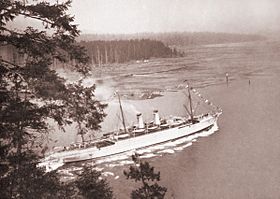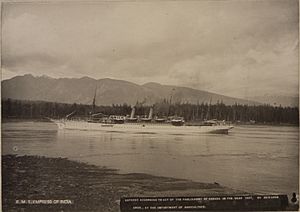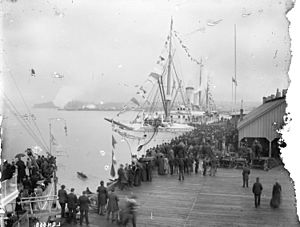RMS Empress of India (1890) facts for kids
class="infobox " style="float: right; clear: right; width: 315px; border-spacing: 2px; text-align: left; font-size: 90%;"
| colspan="2" style="text-align: center; font-size: 90%; line-height: 1.5em;" | 
|} The RMS Empress of India was a large passenger ship, also known as an ocean liner. It was built in England between 1890 and 1891 for a company called Canadian Pacific Steamships. This ship was the first of two vessels owned by Canadian Pacific to be named Empress of India.
On April 28, 1891, the Empress of India was the very first "Empress" ship to arrive at Vancouver harbor in Canada. For many years, it regularly traveled across the Pacific Ocean. Its route connected the west coast of Canada with countries in the Far East. In 1914, the ship was sold to the Maharajah of Gwalior and renamed Loyalty in 1915.
In 1891, the Canadian Pacific Railway (CPR) and the British government made a deal. They agreed on a contract for mail service between Britain and Hong Kong through Canada. Three special ocean liners were designed for this important route. Each of these three ships was given a name that sounded grand and "Imperial."
The Empress of India and its two sister ships, RMS Empress of China and RMS Empress of Japan, formed the main part of the CPR's Pacific fleet. These ships sailed this route for the next 50 years.
Contents
| History | |
|---|---|
| Name |
|
| Owner |
|
| Port of registry |
|
| Builder | Naval Construction & Armaments Co, Barrow-in-Furness |
| Laid down | 1890 |
| Launched | 30 August 1890 by Lady Louisa Egerton |
| Maiden voyage | 8 February 1891 |
| Fate | Scrapped in 1923 |
| General characteristics | |
| Type | Ocean liner |
| Tonnage | 5,905 tons |
| Length | 455.7 ft |
| Beam | 51.2 ft |
| Propulsion | Twin propellers |
| Speed | 16 knots |
| Capacity | As originally configured: 120 first class, 50 second class and 600 steerage |
The Ship's Journey and Design
The Empress of India was built by Naval Construction & Armaments Co. in Barrow, England. This company is now part of Vickers Armstrongs. The ship's construction started in 1890. It was officially launched on August 30, 1890, by Lady Louisa Egerton.
This ship weighed 5,905 tons. It was 455.6 feet long and 51.2 feet wide. The ship was painted white and had a sleek, curved bow. It featured two tall, buff-colored funnels with black tops. It also had three light masts, like those on a schooner. The ship could travel at an average speed of 16 knots.
The Empress of India and its sister ships were special because they were the first in the Pacific to have two propellers. These were powered by special engines called reciprocating engines. The ship was designed to carry many passengers. It could hold 120 first-class passengers, 50 second-class passengers, and 600 steerage passengers.
First Voyage and Regular Route
The Empress of India began its first journey on February 8, 1891. It left Liverpool and traveled through the Suez Canal to Hong Kong and then to Vancouver. After this first trip, the ship regularly sailed a specific route. This route included stops in Hong Kong, Shanghai, Nagasaki, Kobe, Yokohama, and Vancouver.
In the early days of wireless telegraphy, ships used special call signs. The call sign for the Empress of India was "MPI."

Ships often faced unexpected situations during their journeys. For example, the Empress of India was once held in quarantine in Yokohama. This happened when a passenger traveling from Hong Kong to Kobe showed signs of smallpox. The ship had to stay in port until the time for the disease to show up had passed. Also, the cargo areas of the Empress were regularly checked by port officials. This was a normal part of business in ports like Hong Kong, Yokohama, or Vancouver.
On August 17, 1903, the Empress of India was involved in a collision. It crashed into and sank a Chinese warship called the Huang Tai.
Later Life and New Name
The ship was reported as sold on December 19, 1914. It was bought by Scindia of Gwalior, also known as the Maharajah of Gwalior. The former Empress was then changed into a hospital ship. It was used to care for Indian troops during wartime. On January 19, 1915, the ship was given a new name: Loyalty.
In March 1919, the ship was sold again. This time, it was bought by The Scindia Steam Navigation Company Ltd. in Bombay (which is now called Mumbai). Finally, in February 1923, the ship was sold for scrapping. This means it was taken apart for its materials in Bombay.
Other Ships Named Empress of India
It can be a bit confusing, but there were actually two ships owned by Canadian Pacific named Empress of India.
- The first SS Empress of India was the ship we've been talking about. It weighed 5,905 tons and was launched in 1890 from Barrow, England. This ship was sold in 1914, renamed SS Loyalty in 1915, and taken apart in Bombay in 1923.
- The second SS Empress of India was a much larger ship, weighing 16,992 tons. It was launched in 1907 in Germany. Canadian Pacific bought it in 1921. For a short time, it was actually named Empress of China before being renamed Empress of India. This second ship was later renamed several more times before being taken apart in 1929.
See also
- CP Ships
- List of ocean liners
- List of ships in British Columbia


